Farm workers in Scottish agriculture: case studies
Case studies examining farm workers in Scottish agriculture and the international seasonal migrant labour market.
4 Worker characteristics, recruitment mechanisms and pathways
Section Summary:
Recruitment agencies were also used as a source of new workers or to ‘top up’ returnees and referrals. Workers are often recruited initially through an agency and shifted to a direct recruitment pathway in future seasons.
The majority of the workforce was experienced and highly capable, with most having some previous experience of farm work, including some with experience on other farms and/or in other countries.
The number of months worked varies dependent on farm type and crops grown, with three categories of seasonal worker: short term (2-3 months); ii) medium term (3-6 months); and iii) long term or multi season. The length of season and numbers employed at different times varied across case studies, with fruit farms having relatively long seasons, but requiring higher numbers during an intensive 2-3 month activity peak.
On most farms a smaller cohort of highly ‘keystone’ experienced workers with central roles existed; they usually worked very long seasons or followed a multi season pattern, spoke multiple languages and acted as supervisors and trainers.
Most workers had been employed in their home countries before coming to work in Scotland across a broad range of sectors and many were educated to degree level. Most had some experience of farm work, although for many this had been gained in Scotland/the UK in previous seasons. Some newer workers (including a student component) had limited/no experience.
Most workers returned home at the end of the season, with some following a multi-season pattern of working on the same farm and a minority working on more than one farm (including farms in England/Europe)
The majority of workers did not work for multiple farms in the UK or elsewhere, due to the travel costs and the potential to save more working a longer season on one farm. The number of months work available on their main farm was a key determinant on whether workers worked elsewhere, with workers seeking additional seasonal work doing so to ‘top up’ their earnings.
4.1 Background Literature
There is a plethora of literature on the diverse recruitment and employment practices pertaining to migrant labour, and the corresponding impact on employer-labourer relations. Findlay and McCollum (2013) offer a useful five-fold typology (Table 5) for evaluating the various ways in which migrants from East and Central Europe are recruited, employed and managed in the UK’s agribusiness sector. These range from so-called ‘gangmaster’ regimes (where labour providers are responsible for the day-to-day management of workers, and are thus omnipresent at production sites) to employer-led recruitment of both temporary and permanent staff.
While the latter approach is most common in the hospitality sector, smaller agribusiness firms were found to directly employ labour using “ informal networks” (which are themselves becoming significant recruitment tools) for short-term work such as planting or harvesting periods. Further, gangmaster and employer collaborations, where the businesses themselves manage workers, were found to be the most common relationship during this research. This enables firms to get “ extra workers during planting or harvesting seasons and… in response to frequent and significant fluctuations in demand for their products (and thus in the requirement for labour)” (Findlay and McCollum, 2013).
Table 5: Agribusiness migrant labour recruitment, employment and management typologies
| Label | Labour chosen by | Wages from | Labour Managed by | Employment status |
|---|---|---|---|---|
| Gangmaster dominated migration regime | Labour provider | Labour provider | Labour provider | Temporary/fixed term. Some later employed by employer |
| Gangmaster–employer collaborative system | Labour provider | Labour provider | Employer | Temporary/fixed term. Some later employed by employer |
| Conventional recruitment agency system | Labour provider | Employer | Employer | Usually temporary/fixed term. Some kept on by employer |
| Employer-led recruitment of temporary workers | Employer | Employer | Employer | Temporary/fixed term. Some kept on by employer |
| Employer-led recruitment of permanent staff | Employer | Employer | Employer | Permanent |
Source: Adapted from Findlay and McCollum (2013)
Previous research reported a lower tendency for A8 migrants in Scotland to find employment via recruitment agencies compared to the rest of the UK, suggesting that Scottish businesses are more likely to employ migrant labour directly rather than through gangmasters or agencies (McCollum et al., 2012). This has important implications for understanding the extent to which seasonal migrants are, but perhaps more crucially, are not directly associated with agriculture businesses (i.e. being supplied via gangmasters). Where gangmaster-supplied labour is used, the aforementioned JAC may underestimate actual seasonal migrant labour numbers – with some perhaps being recorded by agricultural holders as regular contract labour days (i.e. the farmer simply employs a third party to manage the crop, that may use gangmaster-supplied migrant labour).
Overall, gaining better understandings of the routes through which migrant workers are recruited is crucial. While recruitment agencies may offer security and stability, they also directly impact wages because they charge fees (Parutis, 2014). Rogaly (2008) suggests that some new workers are more likely to be reliant on gangmasters for information about jobs, as well as transportation and access to credit and accommodation, which creates power imbalances between employer and employee. However, information also spreads by word of mouth between employees, but this is often incomplete or inaccurate (Kay et al., 2016).
There is some evidence that whilst agencies serve as initial routes into UK labour pools, migrants will become transient once they have experience. Parutis (2014) outlines how migrants often come to find “any job” and then seek a “better job”, before aspiring to find a permanent “dream job”. These transitions often entail moving between sectors, which is especially important in the Brexit context because barriers to agricultural work may have implications for other migrant-heavy industries such as hospitality or construction.
4.2 Farmer/stakeholder perspectives on recruitment mechanisms
Workers returning to farms for which they have worked previously (returnees) represented the cornerstone of the seasonal workforce for most farms across the survey respondents and case studies. This established mechanism benefitted both farms and workers because it ensured farmers were aware of their returning employees’ capabilities, workers were familiar with the farm and the systems of work, and (in some cases) were able to take a more direct recruitment pathway and avoid recruitment agency fees. Farms often relied on their returnees to ensure sufficient worker numbers and to provide an experienced core of employees to spread across worker teams.
Nearly all survey respondents relied, to differing degrees, on returnee seasonal workers (Table 6). The results suggest that around half of Scotland’s seasonal migrant agricultural workforce are returnees, indicating a high level of worker satisfaction with their previous years’ employment conditions. The second most important form of seasonal worker recruitment (18% of the workforce) was through recruitment agencies (both located in the UK and in the EU). Farm businesses reported that they thought 13% of their workers were recruited through existing or formal employee referrals indicating the importance of informal networks) with 10% recruited directly by the business in the worker’s home country.
Specifically, the larger employers are using their existing non- UK staff expertise and networks during the off-season to undertake annual recruitment events in countries where they target universities, local villages and town halls. They may directly conduct in-country interviews, or use this approach to raise awareness and direct prospective workers to their online application forms. For specialist tasks, such as picking daffodils or bulbs, there is often reliance on communication networks to inform pickers when the season will start on Scottish farms. Many businesses also work directly with recruitment agencies that have in-country representatives in key countries.
Table 6: Recruitment pathways of seasonal migrant workforce – Farm business perspective
| Source | Businesses | Average % of Workers | Estimated Survey Workforce | |
|---|---|---|---|---|
| Returnees | 56 | 62 | 4,130 | (49%) |
| Recruitment firm | 30 | 30 | 1,502 | (18%) |
| Referrals | 33 | 22 | 1,104 | (13%) |
| Own direct recruitment outside the UK | 19 | 10 | 811 | (10%) |
| Media / advertising | 14 | 4 | 220 | (3%) |
| Other farms / labour providers | 14 | 18 | 217 | (3%) |
| Workers sourced through social media | 16 | 7 | 255 | (3%) |
| Other, please specify | 10 | 14 | 109 | (1%) |
The returnee component varied in size across the survey and case study farms. On the case study farms, returnees accounted for 20-65% of the seasonal workforce, commonly making up around half of the workforce. Table 7 summarises staffing, business turnover and seasonal migrant characteristics, including recruitment pathways for farms in the case studies. Total worker numbers increase with farm size (turnover), with a significant jump in worker numbers on large fruit farms (which average 495 seasonal workers). Table 7 also shows the main origins of the workers, with Bulgarians and Romanians constituting the majority on most farms. The returnee component is generally higher on farms with established direct recruitment mechanisms, longer seasons and strong reputations among the seasonal migrant workforce.
Returnees also play a role in referring other migrant workers to the case study farms (a point confirmed by workers themselves), thereby providing a key stream of new workers (referrals/invitees), with referrals commonly constituting 10-20% of the workforce and as much as 40% in some cases. Experienced returnees often played a key role in recruitment, with one long term Latvian worker on a smaller vegetable farm having connections to the majority of the farm workforce through referrals of friends and family members and people from his local region. Nevertheless, as one experienced supervisor on a large fruit farm noted, referrals should be carefully checked to avoid unfair treatment and potentially illegal practices:
- “Some people do bring people…ok, but as soon as people start to bring 20-30 workers and they charge the workers so this is really not right….this is maybe a reason why people don’t choose certain farms, because there is a person like this who charges people to bring them over.”
Table 7: Worker origins, staff costs and labour sources
| Case Study | Turnover / Wage bill/ staffing | Worker Origins | Recruitment (returnee %) |
|---|---|---|---|
| Fife Veg | Average: £1-2M £150,000 wages^ 4 permanent & 22 seasonal migrants | Bulgaria, Romania and Latvia | Combination of returnees (Avg. 50%) agency provision and referrals. |
| Tayside Mixed | Average: £1.6M £600,000 wages 8 permanent & 115 seasonal migrants | Bulgaria/Romania dominant; Polish, Czech, Lithuanian components (one farm) | Returnees 40-65% (Avg. 48%) Referrals 10-35% (Avg.18%); Agency 0-50% (Avg. 30%), Some direct/via social media. Lower agency reliance due to farm-worker relationships. |
| Soft Fruit | Average £5M £1.7M wages 29 permanent & 495 seasonal migrants | Bulgaria/Romania dominant but greater diversity; Czech, Slovakia, Polish; minority Italian /French | Returnees 20-60% (Avg. 37%), Referrals (Avg. 25%), Agencies 5-70% (Avg. 33%), Some direct/social media recruitment (Avg. 25%). |
| Labour Providers | Turnover & wage data not provided Up to 300 seasonal migrant workers | Relatively mixed: Romania, Bulgaria, Polish, Latvia, Lithuania, Slovakia and Czech. | Staff more (semi-) permanent but with turnover. Returnees Avg. 50%, Referrals Avg. 30% Agencies Avg. 20%. Combination of permanent and more seasonal |
| ^ partial estimate | |||
Specialist recruitment agencies (see In Focus Box 2 for an example) also played an important role as a source of seasonal labour for the case study farms, with two of the largest agencies ( HOPS Labour Solutions and Concordia) estimating they each supplied in the region of 15% of Scotland’s seasonal agricultural labour needs. In many cases agencies were used (together with referrals) as a source of new workers or to ‘top up’ the returnee and referrals contingent. Returnee workers had often been recruited initially through an agency (in their first season), with the agency providing a basic contract and both the worker and farmer paying a fee for the service. As these workers gained experience with a farm they commonly switched to a direct recruitment approach to avoid paying agency fees. In practice, many workers placed on a farm via a recruitment agency will have originally heard about the job through word of mouth, and therefore constitute formalised (agency managed) referrals.
The use of recruitment agencies varied widely between case study farms. A minority did not use agencies, but one large fruit farm used an agency to recruit 60-70% of their seasonal workforce, with most farms recruiting at least 10-20% of their workers through agencies. The reliance on agencies was more evident on farms which lacked an emphasis on active direct recruitment (e.g. referrals, recruitment via a farm website and active in-country recruitment), with some larger farms emphasising direct recruitment efforts following the expansion of the EU and the closure of SAWS. Some of the larger fruit farms had engaged in direct in-country recruitment in the past, with a minority considering recruitment visits to Romania and/or Bulgaria should labour availability decline further.
In Focus Box 2 Recruitment agency example: The Concordia Farm Programme
Concordia is a charity established in 1943 with the aim of supporting the war effort and addressing shortages of young male workers through recruiting volunteer labour to work on farms. Concordia remains a charity and continues to promote international volunteering abroad and in the UK. The organisation also plays a role in recruiting seasonal international labour to work in the UK horticultural industry, with the aim of fostering cross-cultural understanding between citizens of different nations. Concordia is a self-sustaining charity, which uses income derived from recruitment and worker placement to reinvest in pastoral support and development of workers (e.g. English lessons, repatriation following illness etc.).
Farms on which workers are placed are inspected directly by the organisation to ensure a high level of ethical/legal standards and quality accommodation. Concordia membership also provides workers with travel, repatriation, health and dental insurance and workers are provided with a welcome pack including specific details on the farm and surrounding area. Concordia recruits (with a current emphasis on Romania Bulgaria and Lithuania) through contracted in-country agents licenced by the UK’s GLAA. Workers are interviewed (often twice) and given an English test, following which they may be offered a role immediately or at a later date, subject to suitability and labour demand.
When workers are placed with UK farms the farmer pays a finder fee and the worker also pays Concordia a placement fee. From a farmer perspective Concordia have an established reputation and provide access to a large labour pool (of new workers). Farmers are not charged should the worker return home within 28 days, with Concordia addressing worker shortfalls where feasible. The organisation places some 10,000 foreign workers into the UK (with roughly a quarter going to Scotland) on an annual basis, with a peak in the summer months to the end of September due to an emphasis on soft fruit.
Farmers identified the main benefits of using specialist recruitment agencies as:
1. Providing greater control over the number of workers arriving for work (e.g. in comparison to the uncertainty of a direct recruitment approach based on advertising/social media etc. and relying on returnees to return), with agencies seen as a safety net which to some extent guaranteed worker numbers and where possible addressed worker shortfalls.
2. Having the capacity where necessary to address unforeseen worker shortfalls at relatively short notice (i.e. mid-season).
3. Providing reassurance that workers have been be sourced ethically and within the law, that documentation was correct and that workers would be given a degree of pastoral care while in country.
4. Some farmers also acknowledged that agencies represented a source of useful advice on how to increase their attractiveness to workers and increase their likelihood of returning (i.e. providing a wider perspective/base of experience).
5. The larger agencies also acted in a lobbying capacity, thereby playing a recognised role in protecting labour availability in the future.
Nevertheless, farmers also recognised that acquiring labour through agencies was an additional expense and a number of farmers raised concerns around agency shortfalls on labour requests in 2017 and whether agencies could be relied on to acquire sufficient labour in the future.
4.3 Farmer/stakeholder perspectives on seasonality of labour needs
The length of the main season of activity varied by farm type (and the crops being grown and harvested) and farm practices, including the emphasis on polytunnels. In particular, vegetable farms in the case studies (see Table 8) exhibited a higher level of activity later in the season (autumn/early winter), with most workers staying 3-5 months, while mixed farms had a summer peak but with around a quarter of their workforce staying for 6-9 months. In some cases farms shared workers early (or late) in the season to allow them to complete a full working week when the available workload is diminished . In contrast, large fruit farms commonly had a long season (10-11 months in some cases) but usually with an intensive 2-3 month peak in activity which required a high level of shorter term labour, with a smaller cohort (15-20% experienced returnees) staying for longer on these farms, including a number of very experienced workers working extended seasons.
Table 8: Seasonality and worker pathways
| Length of Season/peak | |
|---|---|
| Fife Veg | Season is crop type dependent, up to 8 months (spring to early winter) with 3-4 months peak. Majority stay 3-5 months, with minority longer term (5-8+ months). |
| Tayside Mixed | Season 9-10 months (March-Nov), peak June-Aug/Sept. Significant component (about 45%) stay 3-5 months and about 25% stay 6-9+ months. |
| Soft Fruit | Season 10-12 months, peak June-Sept, shorter major (2 months) peaks on some farms; high emphasis on shorter term labour - 65% staying <2 months, 23% 3-5 months and 17% over 6 months. |
| Labour Providers | A 12 month season peaking somewhat in Sept-Nov. Majority 6-8+ months. |
The length of seasonal migrant stays on farms was provided in the survey returns. Figure 11 shows that 74% of farms reported having workers stay between 1 and 2 months, accounting for an estimated 29% of the total seasonal migrant workforce directly employed by farms. 74% of the farms (38% of the workforce) had workers stay for 3 to 5 months, while 72% of farms (17% of the workforce) had workers employed for 6 to 8 months. Small proportions of the seasonal migrant workforce were employed for either less than 1 month (7%) or more than 9 months (9%).
These findings were consistent with the evidence gathered through case study interviews and with Andersons (2017) for example, who state that many soft fruit workers are “ typically working for a 20–25 week season.” This does, however, reiterate that the pattern of seasonal migrant labour use is highly varied.
Figure 11: Proportion of farms with seasonal workers by length of stay and proportion of seasonal migrant workforce by length of stay
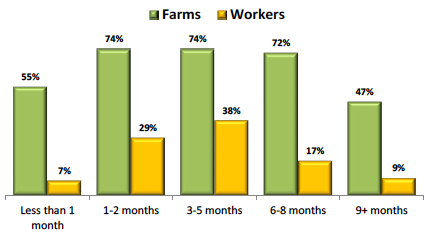
Data from the farm business survey provided an overall snapshot of the various monthly uses of seasonal migrant labour (Figure 12). This, once again, highlights the highly variable nature of demand for seasonal migrant labour, which is driven by their specific farming needs.
Figure 12: Seasonality of migrant worker use by farm business survey respondents
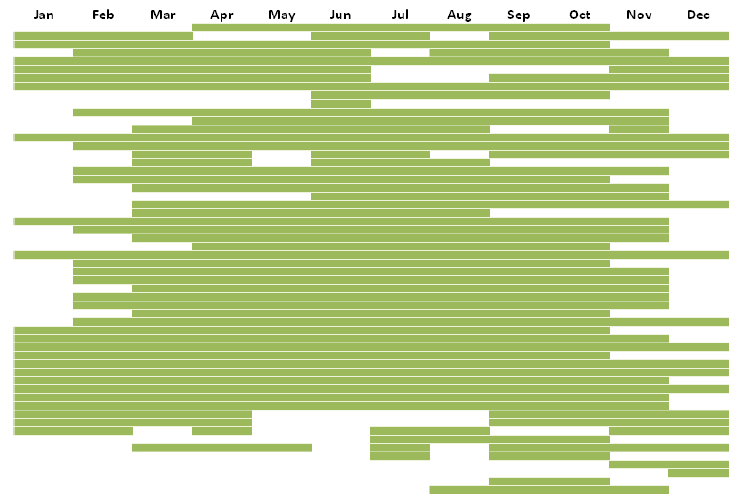
4.4 Worker perspectives on experience, pathways and progression
At the outset it was acknowledged that the workers were a ‘hard to reach’ population with no worker database nor any direct means of communicating with workers (and thereby advertising the questionnaire) other than through leaflets distributed on 10 farms that agreed to provide access to their workforce, and a targeted Facebook campaign (all in multiple languages). It is acknowledged that it is highly unlikely that this is a representative sample of the migrant workforce, due to the nature of the promotion of the survey and the fact it occurred relatively late in the fruit picking season. Nonetheless, the worker survey responses allow characteristics of a sample of workers to be observed. The majority of the respondents were from Romania (29%), Poland (28%), Bulgaria (26%) with 7% from Latvia and only 3% from the Czech Republic.
4.4.1 Worker characteristics
Figure 13 shows that overall 36% of the respondents were female, with 62% male and 2% preferring not to say. The majority of the respondents (76%) were in the 20-40 year old bracket, with 17% over 40 and only 7% under 20 (perhaps reflecting the farmer observation that there are now far fewer students on working holidays).
The worker respondents were generally educated beyond school with 46% having further education qualifications, with 28% having either an undergraduate or postgraduate degree. A quarter of the worker respondents classified their spoken English ability as ‘advanced’ with 39% as ‘intermediate’ and 36% as ‘beginner’. The lack of English ability in some workers was raised as an issue by some farmers, who mentioned difficulties in communicating tasks, etc.
Seventy-eight per cent of the respondents claimed to have had prior farm experience before taking their job in Scotland in 2017, with nearly 40% having worked on farms for more than five years. Only a fifth of the respondents said they had less than a year of prior experience on farms, suggesting that the majority of the workforce have some background in farm work with a cohort having long term experience.
Figure 13: Worker survey respondent characteristics
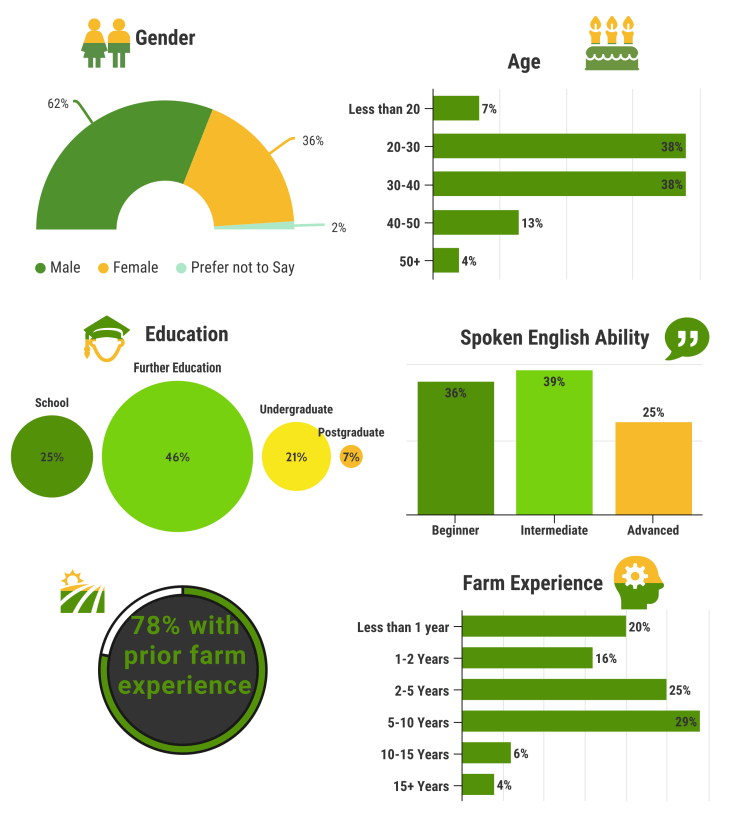
The worker survey revealed a similar picture of recruitment pathways to the farm business survey. Word of mouth was the most prevalent method of pathways into work, with 36% having had connections through friends or family, and 13% having heard about work from existing / former employees. About 40% of the workers had come through recruitment agencies (29% from within their own country) with very few coming directly through advertisement or social media (5%).
Two thirds of the worker respondents had been coming to Scotland for three or less seasons (Figure 14). For 32% of the respondents, 2017 was their first year working in Scotland and for 36% of the respondents this was the first year working for the business they were employed by. For 16% this was their second year in Scotland with a similar portion coming for a third year. The high level of returnees as reported by the farmers is perhaps witnessed by the fact that there is a high degree of correlation between the lengths of time a worker has come to Scotland with the number of years they have worked for their existing employer. Overall 30% of the respondents had been returning to Scotland for more than five years with 7% coming for 10 or more years. This reconfirms that there is a degree of satisfaction with Scottish farm work and that it fits in with these respondents’ expectations and life goals.
Figure 14: Worker experience in Scotland
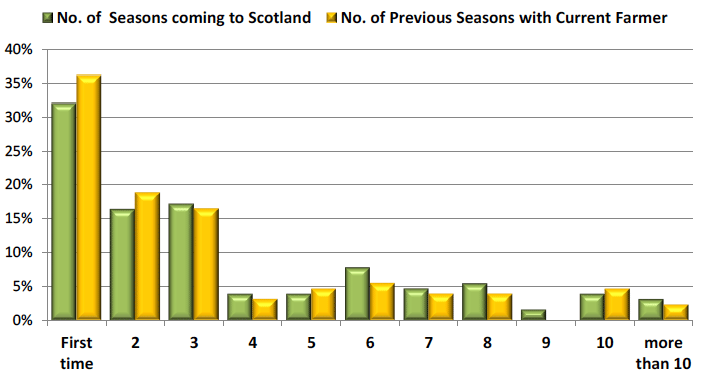
The worker respondents were also asked about how long they expected to work in the UK during the 2017 season and interestingly 21% reported that they expected a full 12 months of work, meaning they did not expect to return to their home country to live during the year. Care has to be taken in interpreting this as full time employment for a single business, although there is likely an element of that, as we know some of these workers are employed by more than one business over the season. Only 11% of the workers expected to work in the UK for less than three months, with 28% expecting 3-5 months UK work, 22% 6 to 8 months UK work and 40% expecting 9 or more months work in the UK. When compared to the farm business survey, this suggests there could be a degree of sampling bias (towards more permanent workers) in the worker survey, although many seasonal farm workers will go on to (or have expectations to) work in other sectors of the UK economy once they finish with their farm employment.
Figure 15: Length of time worker respondents expect to work in the UK in 2017

Experience of workers interviewed in the case studies ranged from those with no previous experience of seasonal farm work in Scotland or elsewhere (e.g. students), to long term, highly experienced returnees. The majority of worker interviewees demonstrated an awareness and (often considerable) experience of agricultural work, with returnee workers generally providing a core of experienced staff on case study farms. This group commonly included a core of very experienced long-term returnees (i.e. with more than 5 years of experience on the farm), who often had central/supervisory roles; these workers usually worked long (8-11 month) seasons or followed a multi season (2-3 visits of 3-4 months in a year) pattern, with extended leave breaks in between these working periods. These longer-term experienced workers often spoke multiple languages, set up and supervised worker squads, initiated and training new workers and in some cases played a role in the recruitment of workers for farms (a point confirmed by farmers). These ‘keystone’ workers commonly multi-tasked, and in some cases they played the role of camp wardens or caretakers and provided general support for the wider workforce (e.g. in relation to English language paperwork).
Among the workers interviewed, many had gained their agricultural experience in Scotland (or the wider UK) and often on a single farm where they had remained for multiple seasons, with strong farm-worker relationships key to their return year-on-year. In most interview groups there were also workers who had gained experience on other farms in Scotland (and the wider UK), and usually a minority that had experience of agricultural work in other countries (examples included Spain, Germany, Italy and Greece), including their home countries. Some workers also pointed out that they had a family background linked to farming and a general awareness of agriculture, with some having worked informally on family smallholdings. As one Bulgarian worker on a mixed farm stated:
- “Many of us almost have a habit of working in agriculture since childhood…so it’s normal almost convenient…for us it is sweet…in the village where I am living currently…many people are looking after raspberries…so it is not far away from my way of living and some of us grew up like that, with farming around us”.
Some workers from across the case studies also had experience of working in other sectors, including factory work, building and transport.
4.4.2 Worker pathways and employment in other countries
The worker survey revealed that 63% of the respondents had some prior farm work experience in their own country (Figure 16) before coming to Scotland (remembering that 22% came with no prior farming experience). Twenty-eight per cent had worked in other parts of the UK, which reiterates the findings from the literature and discussions with stakeholders who talk of seasonal pathways from the south west of England, into East England and up into Scotland due to differing seasonal peaks in demand (particularly in the flower sector). The respondents had also worked on farms in a wide range of countries, outside their home country, suggesting that for some respondents seasonal migratory farm employment was a familiar concept (for example one in ten non-Polish workers had on-farm work experience in Poland).
Figure 16: Seasonal worker respondents previous farm work experience by location
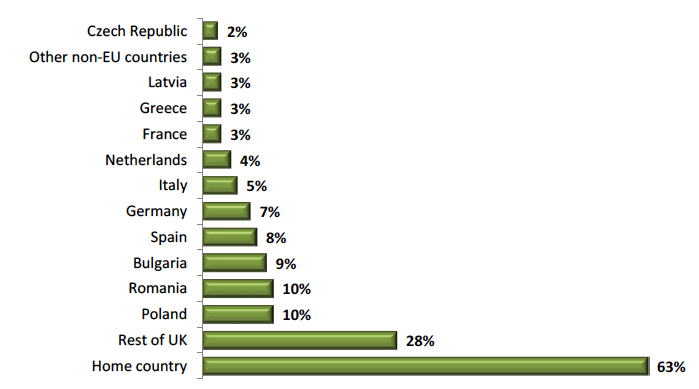
Whilst the survey respondents generally had some level of farm work experience in their home countries, only 22% were directly working on farms (7% permanently and 15% seasonally) before coming to work in Scottish agriculture in 2017 (see Figure 17). One in ten had been unemployed before coming to Scotland, with nearly a fifth being students. Some 39% of the respondents were working in non-agricultural sectors prior to coming to Scotland, showing that many seasonal migrant workers to Scottish agriculture (i) have work experience beyond agriculture, and (ii) give up jobs in home countries to travel to Scotland to work, suggesting it must be economically advantageous to do so.
The worker survey findings were corroborated during the case study interviews. A majority of interviewed workers had been employed in their home countries prior to starting seasonal farm work in Scotland across a broad range of sectors (with workers often having held more than one job), including retail and catering, tourism, manufacturing and warehouse-based work, textiles, fisheries, IT and electronics, building and carpentry, education (teachers), driving/transport, engineering and mechanics, courier work and the public sector. Interviewed workers were therefore often both well-educated and experienced across various sectors.
Figure 17: Activity seasonal migrant workers were doing before coming to Scotland to work in 2017
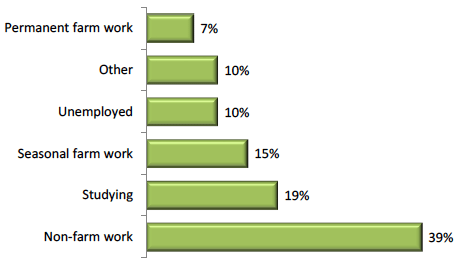
The majority of worker respondents reported that they had funded their travel to Scotland through saving (61%) with about a quarter borrowing money from family and friends. Only 13% reported that they had taken on debt to pay for their travel to work in Scotland. This is perhaps reflective of the age, work experience, and existing UK experience profile of many of the respondents (particularly as stakeholder interviews reveal some workers take on private debt to fund travel to the UK for the first time). About a quarter of the worker respondents had paid an agency fee to ensure their position.
Figure 18: How worker respondents funded travel to Scotland in 2017
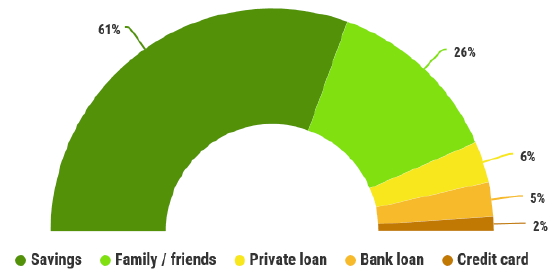
As identified above, many interviewees followed a direct recruitment pathway as returnees, or sourced their employment through a referral/invite from friends or family members working in Scotland. Many newer workers often followed an agency recruitment pathway, either by directly approaching an agency or being referred to one by a farm. Workers themselves often associated agency pathways with providing a better guarantee of employment; however, most viewed it as an expense they would prefer to avoid and were often keen to follow a more direct line of communication with a farm to avoid agency fees.
A minority of interviewees returned home (or to another country) between periods of work in Scotland for a specific seasonal job, including working in ski resorts or other temporary retail or catering jobs, with a small number also using seasonal farm work to support a semi-professional football career in their home country. A student component was also evident among the work force on most farms (usually working short seasons), with the students commonly using their earnings to fund their studies. In many cases experienced seasonal workers had also first started working in Scotland during their studies and continued with this working pattern after completing their degree.
The majority of survey respondents (72%) only worked on a single farm in 2017 with 20% working on two farm businesses, and 5% working on three. After they completed their current employment a third of worker respondents expected to be working in agriculture (mostly in Scotland) with 29% expecting to be working in non-agricultural sectors (mix between Scotland and home country), 15% returning to studies in their home country, and 21% expecting to be unemployed in their own country.
Most interviewees returned home after their period of seasonal work (a point confirmed by farmers) and the most common pathway was home-Scotland-home, although workers sometimes performed this more than once in a year in a ‘multi-season’ working pattern on the same farm (including a proportion of workers on the largest fruit farms). A minority also worked on a second farm in Scotland or England (e.g. a short autumn season on apple farms in England) or worked in England or Europe on temporary non-agricultural (e.g. building) work contracts in the winter. The majority of workers did not work for multiple farms in different countries, largely due to the higher associated travel costs and the potential to save more working a longer season on one farm in the UK where possible. The season length available to them on their current farm was a key determinant in whether workers worked elsewhere, with those seeking additional seasonal work doing so to ‘top up’ their earnings to reach a specific savings target.
Some variation in pathways was evident between case studies (see Table 9), with workers in the vegetable case study more commonly working shorter periods elsewhere earlier in the year (including one group which usually worked on an asparagus farm in England for three months). The majority of interviewees on mixed farms did not work elsewhere, with some doing non-agricultural work in England (e.g. building), Europe or their home countries in the off-season. Among those interviewed on large fruit farms, a minority (of those on shorter season contracts) worked on other farms in the off-season including in England and Spain. Those working for labour providers (which most commonly involved working on potato farms) often followed a multi-season pattern, with these workers commonly working for a mixed farm or fruit farm during the summer months.
Table 9: Case study worker pathways and work experience
| Multi-farm Pathway | Farm Experience / Other Countries | |
|---|---|---|
| Fife Veg | Minority of workers on multiple farms extending season including in non-farm work (creating a summer and late/winter season). Majority returning home | Some with experience in home country (farming background) and England. |
| Tayside Mixed | Majority working on one farm only on all 3 farms, minority building and/or picking elsewhere at season end. | Majority gained experience on case study farm. Some with experience in home country (farming background), other Scottish farms, England and minority in other EU countries. |
| Soft Fruit | Minority working on more than one farm including apple farming in England and picking in Spain, Greece and Italy. | Most gained experience on case study farm. Some with experience in home country (farming background), other Scottish farms, England and minority in other EU countries. |
| Labour Providers | Some workers picking (fruit farms) during summer depending on contracts | Some with experience in home country (farming background) and England. |
Figure 19 summarises the findings from the worker survey and case study interviews and presents a typology of seasonal migrant workers. In this typology workers are categorised into three broad groups (short, medium and long term/multi-season) based on the length of season worked, experience and common tasks and pathways to Scottish farm work.
Figure 19: Typology of seasonal migrant workers in Scottish agriculture
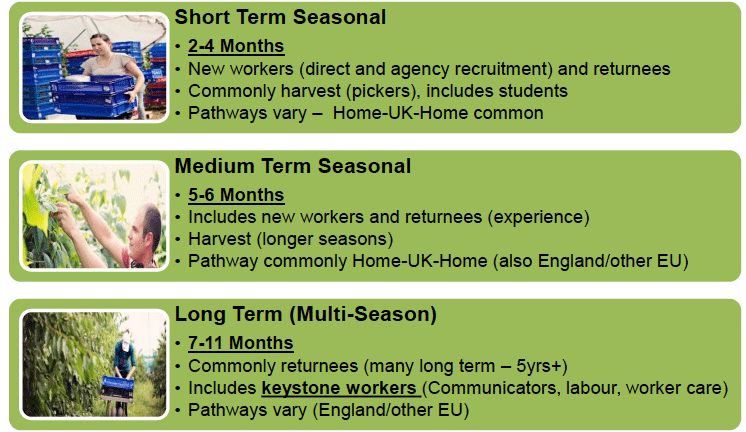
4.4.3 Farmer and stakeholder perspectives on worker progression
Despite the majority of workers returning home at the end of the season, some opportunities for progression existed and farmers commonly promoted some of their more experienced and skilled (and multi-lingual) workers to supervisory roles. Examples of pickers having progressed through the ranks to become team supervisors and main supervisors were evident on most case study farms. In some cases this included workers becoming permanent employees and moving to Scotland on a full-time basis, including some who had started families in Scotland. As one farmer explained: ‘ every few years we get one that finds a substantial role for themselves and stays on…we have eight supervisors that have come that route and most now live here all year’. On some larger farms this included examples of workers having moved into other aspects of the business (e.g. packhouse work).
Some farmers also noted cases where workers had effectively used seasonal farm work as a gateway to employment in other sectors, including food processing and building work, although these interviewees noted this occurred infrequently (as far as they were aware), and of those workers shifting to more permanent roles (on or off-farm) a proportion usually returned to their home countries after a certain period of time. Critically, farmers and wider stakeholders stressed that migrant workers (both seasonal and more permanent) played key roles within the labour force across all aspects of the agricultural supply chain, a factor which is beyond the scope of this report.
Some crossover therefore occurs between seasonal and permanent migrant workers, with a minority of seasonal workers representing a labour stream into other off-farm agricultural businesses (see In Focus Box 3 for an example).
In Focus Box 3 The role of permanent migrant labour in the agricultural supply chain and seasonal worker progression; a cooperative producer group example
Kettle Produce is a vegetable supply business established in 1976 by two farming families in Fife. Kettle grows produce in partnership with over 50 farmers and supplies roots, brassicas, salads and prepared vegetables to major wholesale and retail markets in the UK and Europe – providing a major supply chain component for vegetable farmers. As well as working with Scottish growers, Kettle has established supply partnerships with major growers in England, France, Spain and Portugal, with Kettle Produce Espána SL (based in Spain) formed as a joint venture in 2003. In total over 6,000 hectares of crops grown in the UK and across Europe were supplied to Kettle.
Kettle has two main production sites in Scotland (Balmacolm and Orkie). The business has expanded considerably from an initial turnover of £185,000 to a current turnover of over £110M and an after tax profit of £1.7M in 2016, equating to an annual growth rate of 12.5%. Currently Kettle is responsible for the production and sale of over 100,000 tonnes of fresh vegetables and salad crops and is one of the largest UK suppliers of fresh produce.
In Scotland, Kettle has supply contracts with around 20 growers, most of which employ on-farm seasonal migrant labour – equating to some 557 seasonal workers in the Fife area in 2017. Kettle also employs approximately 1,200 permanent workers at its production sites in Fife, around half of which are workers of non- UK (predominantly Eastern European) origin, many of whom have worked for Kettle for 5-10yrs or more. Kettle also employs additional temporary workers during peak demand periods (particularly Christmas) through two labour providers on short-term contracts, with some of these workers going on to more permanent positions with Kettle due to on-going staff turnover.
The case study farms within the Fife area (and Kettle) recognised some crossover from on-farm seasonal workers and Kettle staff - with the winter activity peaks at Kettle providing off-season (winter) employment for some seasonal farm workers in Fife. Additionally, both farmers and Kettle recognised cases where seasonal farm workers had progressed into permanent employment with Kettle. Critically (as noted by both farmer and Kettle interviewees), the success of Kettle’s partner farms and Kettle as a business were intricately linked – with seasonal and permanent migrant workers playing a major underlying role in the success of both. As identified by Kettle interviewees, business growth has commonly occurred in areas requiring high labour inputs and further growth is also likely to occur in these areas, with labour demand therefore potentially continuing to increase in the future.
Notably, workers at Kettle interviewed for this research commonly identified progression opportunities as a key benefit of working at Kettle. A number of examples of long-term (multi-stage) worker progression were evident, with workers frequently becoming heavily integrated within their local community.
Contact
There is a problem
Thanks for your feedback